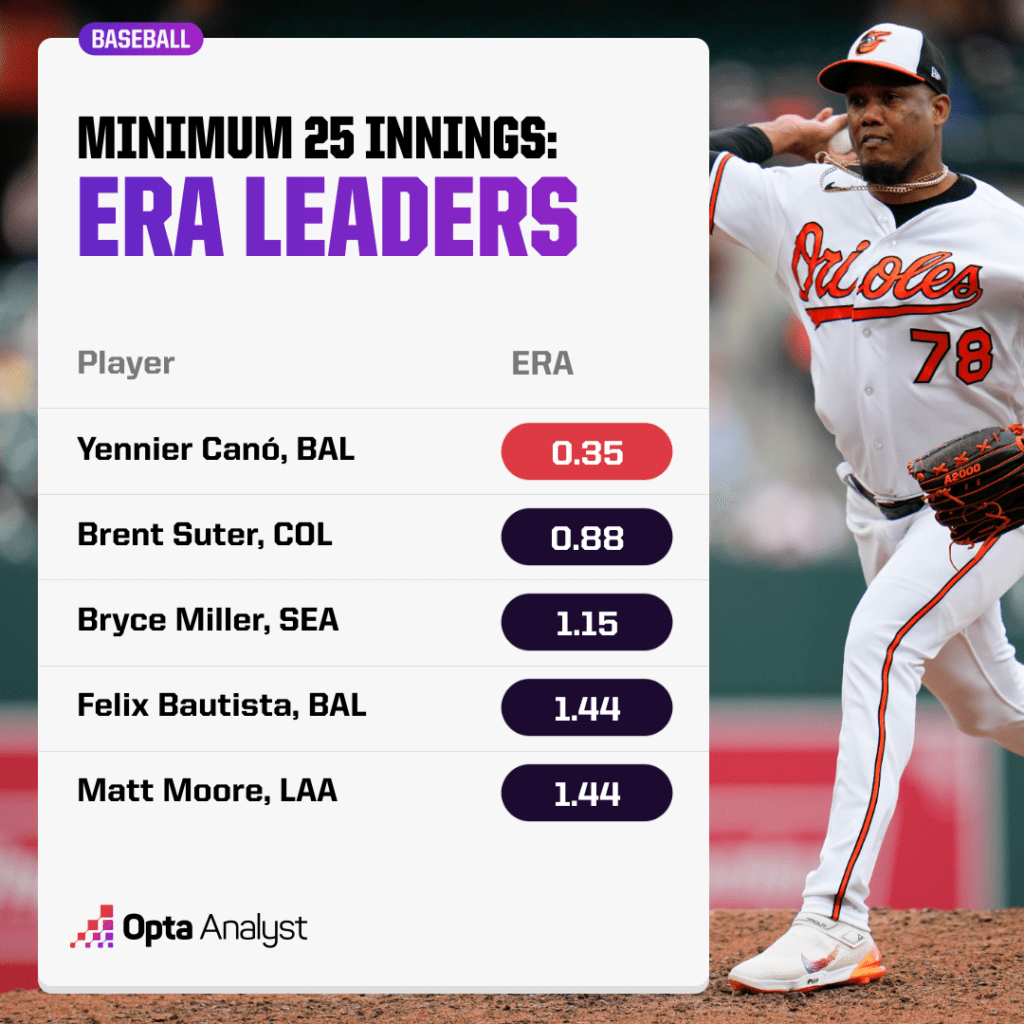Baltimore traded All-Star reliever Jorge Lopez for four arms before the 2022 deadline. We’re examining how one of them has become a rising star and perhaps the nastiest reliever in baseball.
2.33.
That was Yennier Canó’s WHIP in the 2022 season, which consisted of 18 innings between the Minnesota Twins and Baltimore Orioles. His ERA was a much worse 11.50, and he wasn’t really good with any of the two squads.
However, the Orioles’ scouting department saw something in Canó. They had traded All-Star reliever Jorge Lopez for four arms, including him, before the 2022 deadline. Fast forward a year, and we can all say there have been no regrets from Baltimore.
Canó has a microscopic 0.35 ERA and an absurd 0.39 WHIP in 25.2 innings. He was perfect until the Toronto Blue Jays scratched a run off him on May 19.

Our favorite Canó stat is definitely his 0/28 BB/K ratio. Yes, that’s right: he has pitched just shy of 26 innings and hasn’t walked a batter. He’s faced 84 batters without allowing a free pass, which is the 14th most among relievers to start a season over the past 50 seasons. (Mark Eichhorn of the California Angels faced 146 batters before allowing a walk in 1991).
You might be learning about him for the first time this year, but Canó is not exactly a young prospect at 29 years old. The journey he has had to travel to get where he is at the moment has been rocky.
He played in the Cuban National Series for the Tigres de Ciego de Ávila from 2013-16. In 2017, however, his life would change.
His mother had recently died, and Canó and his wife considered leaving Cuba. He followed the regular channels, applying to the Cuban government for permission to go. Instead, he was banned for a full year. He couldn’t play the game he loved.
Cuban officials didn’t even let him practice in his team’s facilities. He had to throw on the streets or wherever he could.
After a year out of baseball, he flew to Argentina to resume his career. There, he trained with Amaro Costa, a former Cuban National Series pitcher for Los Metropolitanos de Habana. And there, he took off. His stuff improved considerably, he learned his changeup from scratch, and he essentially ditched his four-seamer in favor of a moving two-seamer that can be considered a sinker.
A year later, he went to Miami to fulfill his dream. He ended up signing with the Twins, because they offered more than Baltimore, but O’s general manager Mike Elias already had him on his radar.
Elias ended up trading for him after he spent a few seasons in the minors. Before that, in the spring of 2020 and after a recommendation from former major league pitcher Carlos Hernandez (then a coach on the Twins), he lowered his arm slot and his sinker flourished, according to Andy Kostka of The Baltimore Banner.
Still, Canó couldn’t find success in the majors until this year. What changed? Well, he lowered his arm slot even more in spring training.
That was enough for him to get much more movement on his pitches. Both of them. In fact, the two-seamer and changeup have very similar movement profiles, but the latter comes in at about five mph slower. That’s death for hitters.
Canó’s sinker ranks as the best in the major leagues among those who have thrown at least 150 with a 16 raw value- (league average 100; the lower, the better). He gets 6 inches more drop on it than the average two-seamer, and no one with MORE drop than him has as much run as he does. And we haven’t even mentioned that he averages 95.6 mph on it.
The Baltimore righty uses it 54.4% of the time.
The second pitch in his arsenal is an incredible changeup. He throws it 36.6% of the time.
Its 90.4 mph average velocity is the fourth highest in the majors for a changeup among those who have thrown at least 105.
The pitch looks like this:
The nature of his pitches makes him a hurler who thrives by working down in the zone. That’s usually where he tries to attack hitters, particularly with the changeup and especially with two strikes (see below).
A slider that he throws 9.1% of the time completes his excellent arsenal.

We previously mentioned raw value (RV), which measures every pitch of the at-bat to assess and evaluate pitching performance. Most stats only use the outcome of the at-bat, but lots of things happen in a matchup between a batter and a hurler.
RV considers launch angle, exit velocity, sprint speed, bat-missing ability, control, command, horizontal spray angle of the ball, and more. RV comes in two versions: a cumulative stat, which is total raw value, and a rate stat: RV-.
Canó ranks 13th in baseball in total raw value, at minus-8.8. He is a reliever, and this is a cumulative stat. It doesn’t get better than that. He has more total raw value than Pablo López, Aaron Nola, Logan Gilbert and other aces that double his innings total.
In RV-, Canó is at 1, the best mark in baseball for pitchers with at least 20 innings. Individually, RV- perfectly illustrates how nasty his pitches have been: his changeup checks in at -13 (!) and his two-seamer has a 37 RV-. Just incredible.
As you would expect, Canó rates extremely well at all phases of pitching: getting strikes (strike+); executing his plan with every pitch (command+) and missing bats (whiff+). For all three metrics, 100 means average performance and anything higher is desirable.
Canó has a 105 strike+ and a 109 whiff+, both above average but not overly impressive. Where he really thrives is in his extraordinary command+ (110), which makes sense considering his low walk total, and how he limits damage on contact. Hitters have earned a meager 14 BIP+, a stat that rates how good they are at inflicting damage after making contact (100 is also considered average).
It’s difficult to do too much with pitches that move as much as Canó’s, especially when he throws that hard.
We will have to see if the league adjusts to Canó’s arsenal and to what extent. Batters somewhat figured Clay Holmes out – in the sense that he hasn’t been as dominant since last July – so the O’s relief ace is not immune to that.
For now, Canó and the Orioles are enjoying the ride.
Like this? Follow us on Twitter for more.
